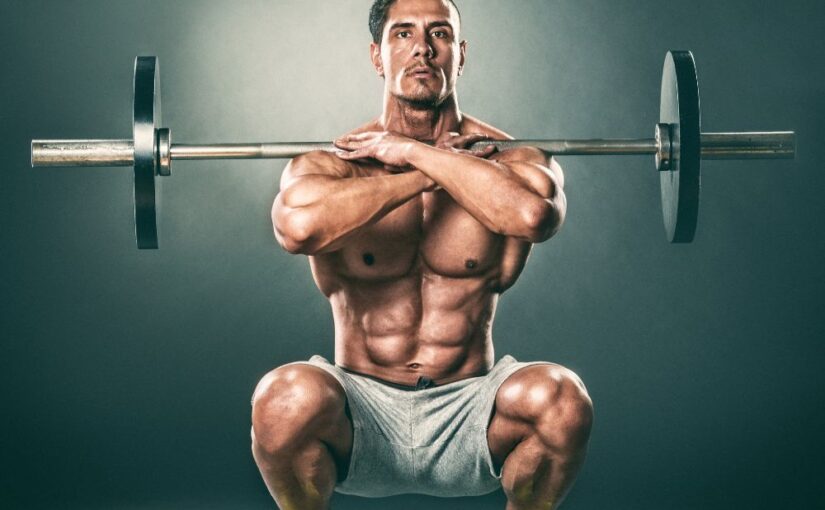Front squats are an effective lower-body exercise that also engages the core and upper body. Unlike traditional back squats, the barbell is positioned in front of the body, which changes the mechanics of the lift and provides a unique set of benefits. Let’s explore the benefits of front squats and why incorporating them into your routine can elevate your workout.
1. Enhances Quadriceps Development
One of the primary benefits of front squats is their emphasis on the quadriceps.
- Muscle Activation: With the barbell positioned in front, there is increased knee flexion during the squat, leading to greater activation of the quadriceps compared to back squats.
- Leg Strength: Stronger quads contribute to improved performance in various activities, from running to jumping.
2. Improves Core Strength and Stability
Front squats require significant core engagement to maintain proper form and balance.
- Core Activation: The upright position of the torso during a front squat demands a strong core to stabilize the spine, enhancing overall core strength.
- Posture Improvement: This emphasis on core stability can translate to better posture in everyday activities and other exercises.
3. Promotes Better Form and Technique
The front squat encourages proper squat mechanics, making it an excellent choice for lifters of all levels.
- Upright Torso Position: The positioning of the barbell helps keep the torso more upright, reducing the risk of forward lean and promoting proper squatting form.
- Technique Focus: Beginners can benefit from the front squat as it emphasizes technique, which can carry over to other lifts.
4. Reduces Strain on the Lower Back
Front squats can be a safer alternative for individuals who may experience discomfort during back squats.
- Spinal Alignment: The more vertical torso position reduces the shear force on the lower back, making it easier on the spine.
- Lower Back Protection: This can be particularly beneficial for those with existing back issues or those looking to prevent injury.
5. Increases Functional Strength
The front squat mimics real-life movements, making it a functional exercise that enhances overall strength and performance.
- Everyday Activities: The mechanics of the front squat translate well to everyday tasks that require lifting, such as picking up heavy objects.
- Athletic Performance: Improved strength and stability from front squats can enhance performance in sports that require lower body strength and explosive movements.
6. Boosts Flexibility
Front squats require and promote flexibility in several areas, including the hips, ankles, and wrists.
- Hip Flexibility: The squat position encourages deeper hip flexion, helping to improve overall hip mobility.
- Ankle Mobility: The need for proper ankle flexion during the squat can enhance ankle mobility, which is beneficial for various physical activities.
7. Versatile and Adaptable
Front squats can be easily modified to suit different fitness levels and goals.
- Variations: You can perform front squats with a barbell, dumbbells, or even kettlebells, allowing for flexibility in your training.
- Progressions: Beginners can start with lighter weights or bodyweight to master the movement before progressing to heavier loads.
8. Time-Efficient Exercise
Incorporating front squats into your routine can yield significant benefits in a relatively short amount of time.
- Full-Body Engagement: Since front squats engage multiple muscle groups, you can achieve a comprehensive workout that builds strength and endurance efficiently.
- Quick Workouts: They can be included in high-intensity interval training (HIIT) or circuit workouts, making them a time-efficient choice for those with busy schedules.
Conclusion
Front squats are a powerful exercise that offers a variety of benefits, from enhanced quadriceps development to improved core strength and functional fitness. Whether you’re a beginner or an experienced lifter, incorporating front squats into your workout routine can lead to significant gains in strength, stability, and mobility. As with any exercise, focus on proper form to maximize the benefits and minimize the risk of injury. So grab a barbell and give front squats a try—you may find them to be a valuable addition to your training program!
Frequently Asked Questions (FAQ)
It depends on your goals. Front squats place more emphasis on the quads and core, while back squats engage the posterior chain more. Front squats are also easier on the lower back and encourage better posture, making them ideal for improving form and mobility.
This exercise targets the quadriceps, glutes, and core. It also calls into play the upper back and shoulders to stabilize the barbell, offering a full-body challenge.
Yes, front squats can be great for beginners when taught with proper form and light weight. They help build foundational strength and promote proper squat mechanics.
One to two times per weeks is ideal for most people. This allows enough frequency to build strength and improve form without overtraining the legs and core.
A barbell is the most common tool for front squats, but you can also use dumbbells, kettlebells, or a sandbag. A squat rack and lifting shoes are helpful for stability and safety.
Recommended Equipment for Front Squats
Training at home doesn’t mean compromising on effectiveness. With the right accessories, you can safely and efficiently perform front squats and build total-body strength.
Barbell Set
A quality barbell and weight plate set allows for progressive overload, making it essential for effective front squatting and full-body strength training.
Squat Rack
A sturdy squat rack helps you position the bar safely for front squats and offers added features like pull-up bars or safety arms for solo training.
Dumbbells
Dumbbells are versatile and great for learning front squat form, offering an easier way to build strength before progressing to barbells.
Kettlebells
Kettlebells are ideal for goblet squats or front rack variations, promoting core engagement and balance while building lower-body strength.
Fitness Sandbags
Sandbags challenge your grip, core, and coordination—great for front squat variations that mimic real-world movement and build stability.
Affiliate Disclaimer: The links above are affiliate links. If you purchase through them, we may earn a small commission at no extra cost to you.

